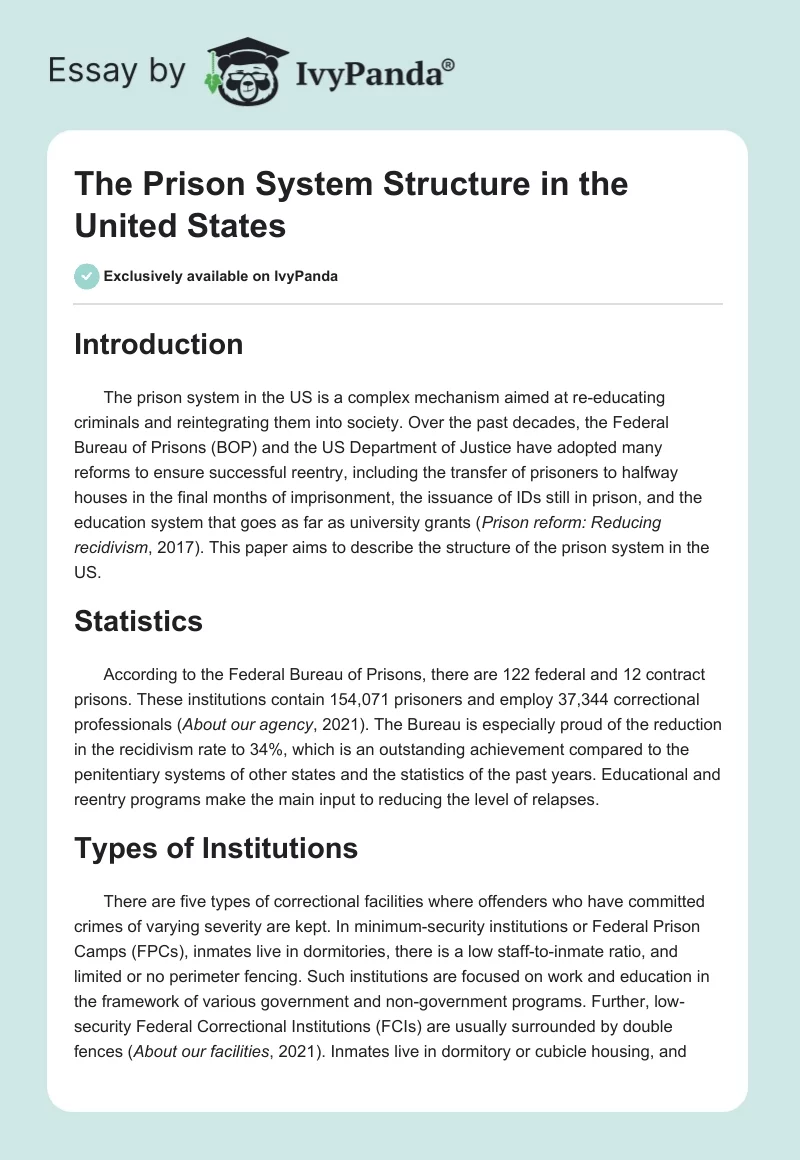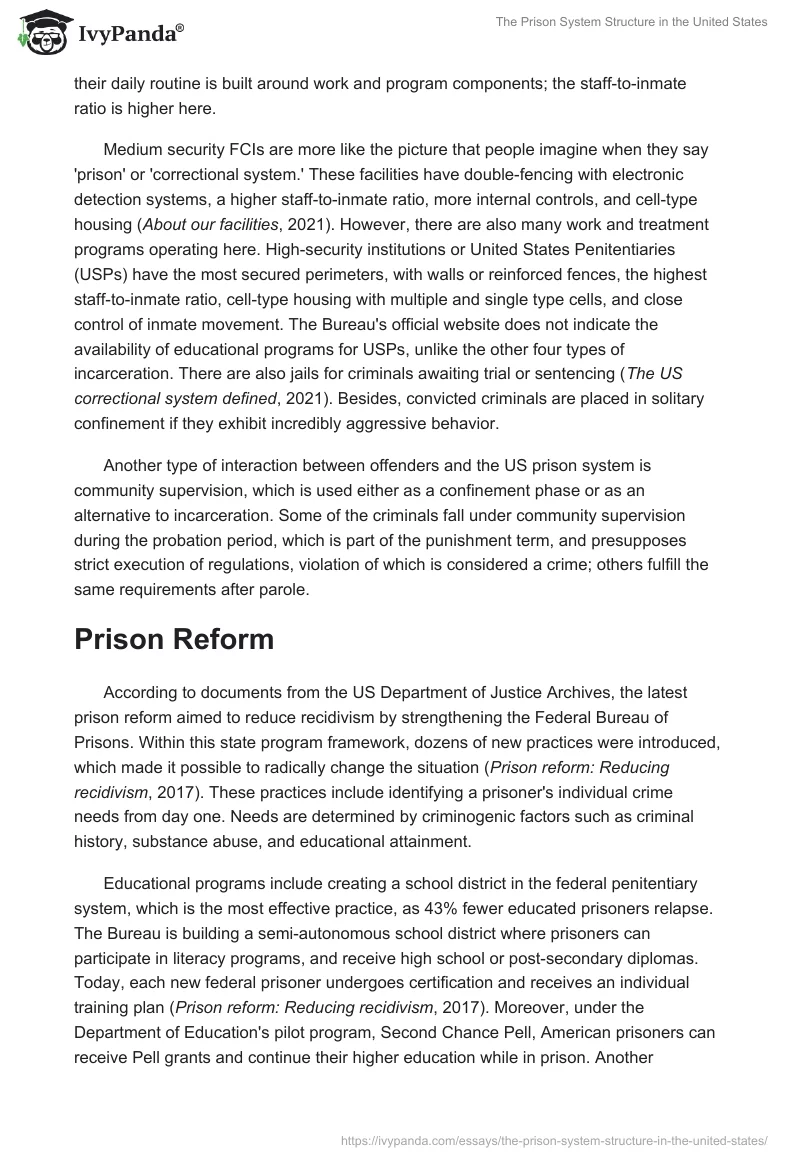Introduction
The prison system in the US is a complex mechanism aimed at re-educating criminals and reintegrating them into society. Over the past decades, the Federal Bureau of Prisons (BOP) and the US Department of Justice have adopted many reforms to ensure successful reentry, including the transfer of prisoners to halfway houses in the final months of imprisonment, the issuance of IDs still in prison, and the education system that goes as far as university grants (Prison reform: Reducing recidivism, 2017). This paper aims to describe the structure of the prison system in the US.
Statistics
According to the Federal Bureau of Prisons, there are 122 federal and 12 contract prisons. These institutions contain 154,071 prisoners and employ 37,344 correctional professionals (About our agency, 2021). The Bureau is especially proud of the reduction in the recidivism rate to 34%, which is an outstanding achievement compared to the penitentiary systems of other states and the statistics of the past years. Educational and reentry programs make the main input to reducing the level of relapses.
Types of Institutions
There are five types of correctional facilities where offenders who have committed crimes of varying severity are kept. In minimum-security institutions or Federal Prison Camps (FPCs), inmates live in dormitories, there is a low staff-to-inmate ratio, and limited or no perimeter fencing. Such institutions are focused on work and education in the framework of various government and non-government programs. Further, low-security Federal Correctional Institutions (FCIs) are usually surrounded by double fences (About our facilities, 2021). Inmates live in dormitory or cubicle housing, and their daily routine is built around work and program components; the staff-to-inmate ratio is higher here.
Medium security FCIs are more like the picture that people imagine when they say ‘prison’ or ‘correctional system.’ These facilities have double-fencing with electronic detection systems, a higher staff-to-inmate ratio, more internal controls, and cell-type housing (About our facilities, 2021). However, there are also many work and treatment programs operating here. High-security institutions or United States Penitentiaries (USPs) have the most secured perimeters, with walls or reinforced fences, the highest staff-to-inmate ratio, cell-type housing with multiple and single type cells, and close control of inmate movement. The Bureau’s official website does not indicate the availability of educational programs for USPs, unlike the other four types of incarceration. There are also jails for criminals awaiting trial or sentencing (The US correctional system defined, 2021). Besides, convicted criminals are placed in solitary confinement if they exhibit incredibly aggressive behavior.
Another type of interaction between offenders and the US prison system is community supervision, which is used either as a confinement phase or as an alternative to incarceration. Some of the criminals fall under community supervision during the probation period, which is part of the punishment term, and presupposes strict execution of regulations, violation of which is considered a crime; others fulfill the same requirements after parole.
Prison Reform
According to documents from the US Department of Justice Archives, the latest prison reform aimed to reduce recidivism by strengthening the Federal Bureau of Prisons. Within this state program framework, dozens of new practices were introduced, which made it possible to radically change the situation (Prison reform: Reducing recidivism, 2017). These practices include identifying a prisoner’s individual crime needs from day one. Needs are determined by criminogenic factors such as criminal history, substance abuse, and educational attainment.
Educational programs include creating a school district in the federal penitentiary system, which is the most effective practice, as 43% fewer educated prisoners relapse. The Bureau is building a semi-autonomous school district where prisoners can participate in literacy programs, and receive high school or post-secondary diplomas. Today, each new federal prisoner undergoes certification and receives an individual training plan (Prison reform: Reducing recidivism, 2017). Moreover, under the Department of Education’s pilot program, Second Chance Pell, American prisoners can receive Pell grants and continue their higher education while in prison. Another innovation was implementing a pilot program for educating inmates on tablets adapted for the prison environment. Other reforms include prioritizing mental health care for prisoners, appropriate substance abuse treatment, and helping inmates maintain family ties.
The changes also affected legal decisions regarding the severity of punishments and conditions of detention. A new attitude involves reducing the use of solitary confinement. The practice of placing juveniles in restrictive housing was officially ended, and limits were put on using imprisonment for low-level disciplinary infractions. The Bureau also plans to reduce and then end private prisons’ practice and strengthen federal halfway houses. Other important innovations are ensuring inmates have IDs before leaving the institution and issuing the “Reentry Handbook” with useful advice for returning to the community.
Communication
Notably, prisoners and their families have many rights, including food, shelter, education, dating, and pocket money. In case of violation of their rights, relatives can file a complaint against the prison (Prisons and prisoners, 2020). BOP also offers a prisoner search service and provides open access to terms and places of detention. This service can be convenient for both relatives and victims of violence. This service may also be a useful tool for the police to track prisoners’ social connections. Interestingly, there are many places for correctional officers’ online communication: only NYC has at least 40 closed Facebook groups (New York City correction-related groups on Facebook, 2017). It is a pity that the same cannot be said for released prisoners, who could also create a network of mutual support.
History
The US prison system had existed since 1891 when Congress passed the Three Prisons Act and established funding for UPS in Leavenworth, McNeill, and Atlanta. By 1930, there were 11 federal prisons in the United States (The history of corrections in America, 2013). Alcatraz Prison, famous in Hollywood films, was opened in 1933 and closed in 1963 due to expensive funding because of the prison location on the island and the cost of transporting provisions (Alcatraz origins, 2021). Remarkably, Alcatraz never had a reputation among the inmates as a creepy place. On the contrary, some prisoners asked for a transfer to Alcatraz due to better conditions. A distinctive feature of the prison was a rigorous daily routine and complete control over prisoners’ movement since this prison held prisoners who refused to obey the rules of other institutions, behaved aggressively towards other prisoners, and were considered dangerous to escape. Over the prison’s thirty-year history, 36 people escaped 14 times, 23 people were caught, six were shot dead, and two drowned; the rest are considered missing and presumably drowned.
Conclusion
Thus, the structure of the prison system in the US was described. Despite the widespread perceptions, only a quarter of institutions are UPSs with high-level security. The rest – medium, low, and minimum-level security FCIs – are aimed at correction of prisoners’ behavior and their reintegration into society. Supporting and protecting prisoners’ rights helps them adapt to their new life after release and significantly reduces the rate of relapse.
References
About our agency. (2021). Web.
About our facilities. (2021). Web.
Alcatraz origins. (2021). Web.
New York City correction related groups on Facebook. (2017). Web.
Prison reform: Reducing recidivism by strengthening the Federal Bureau of Prisons. (2017). Web.
Prisons and prisoners. (2020). Web.
The history of corrections in America. (2013). Web.
The US correctional system defined. (2021). Web.


